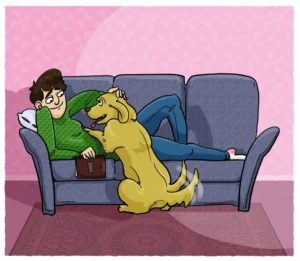Dogs are known for their ability to communicate without words. As dog owners, we cherish our furry friends, but it can sometimes be challenging to decipher their behavior — especially when they put their paws on us. What does it mean, and how should you respond?
In this guide, we’ll break down what it means when your dog places its paws on you and offer four practical exercises to prevent this behavior, with insights from dog behavior expert Rebecca Forrest.

Why Does My Dog Put Its Paws on Me?
1. “I’m Scared or Anxious”
If your dog is in a new environment or you’ve recently lost your temper with them, they might feel stressed or anxious. A dog experiencing insecurity or fear may put its paws on you as a way to seek comfort and reassurance. To determine if this is the cause, check for other signs of anxiety, such as flattened ears, yawning, or lip-smacking.
2. “I Love You”
Dogs often reciprocate affection by placing their paws on their owners. When you pet your dog, they might touch you back with their paws to say “thank you” or “I care about you.” This gesture is linked to the release of oxytocin, the “love hormone,” which both dogs and their owners produce during bonding moments.

3. “I Need Your Attention!”
Dogs form strong bonds with their owners and naturally crave attention. If your dog paws at you, it might be a plea for interaction. Dogs thrive on human affection, and when left alone for long periods, they may seek out your attention as soon as you return.

4. “I’m Hungry”
Another common reason dogs put their paws on you is to signal hunger. If your dog is pawing at you around mealtime, check their food bowl to ensure they have enough to eat. However, always monitor portion sizes to prevent overeating and obesity.

How to Prevent Your Dog from Pawing at You
If you find your dog’s pawing behavior to be bothersome, here are four effective strategies to reduce or stop it:
1. Ignore the Behavior
If your dog’s pawing becomes disruptive, simply ignore it. Avoid eye contact and remove yourself from their reach. Once they calm down, reward them with gentle affection. This teaches them that calm behavior is rewarded.

2. Be Consistent
Consistency is key when it comes to training your dog. If you want to discourage pawing, don’t give in to it intermittently. Over time, your dog will learn that pawing does not gain your attention and will reduce the behavior.

3. Ensure Their Needs Are Met
Make sure your dog’s basic needs are satisfied. Set a regular schedule for feeding, walking, and playtime. A dog that feels well-cared-for and has their needs met is less likely to paw at you for attention.

4. Change Your Position
If your dog starts resting its paws on you, change your position or move away. Making it slightly uncomfortable for them will discourage the behavior, and they will likely stop over time.

Owning a dog means interpreting their unique ways of communicating. While pawing can be cute, it’s essential to understand the underlying reasons behind the behavior to ensure a healthy and happy relationship with your furry friend.
Do you have a dog that frequently paws at you? Share your experiences and tips in the comments below!
By understanding these behaviors and using these prevention techniques, you’ll create a more harmonious relationship with your four-legged friend, while maintaining a loving, affectionate bond.














